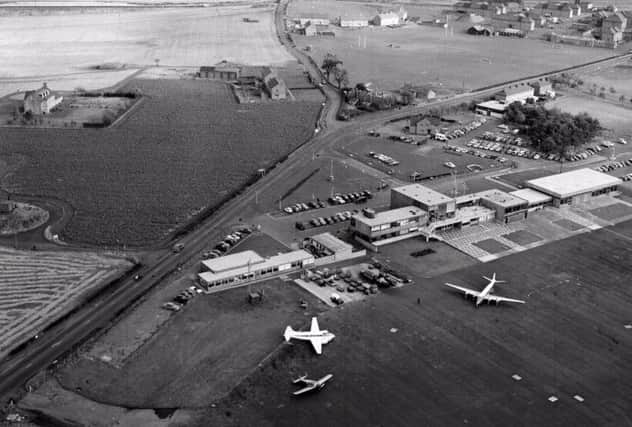Scottish fact of the day: Edinburgh Airport


History
Opened in 1915, Turnhouse Aerodrome was initially home to the Royal Flying Corps.
After the formation of the Royal Air Force in April 1918, the airfield was re-branded RAF Turnhouse, and ownership was transferred to the Ministry of Defence.
Advertisement
Hide AdFrom 1925 it was home to the 603 (City of Edinburgh) Squadron, consisting of DH 9As, Westland Wapitis, Hawker Harts and Hawker Hind light bombers, with all aircraft using a grassy air strip.
The airfield’s proximity to the East Coast railway line led to a number of aircraft arriving in crates by train, and being assembled on the field prior to service.
World War II
At the outbreak of the Second World War, RAF Fighter Command took over the running of the airfield, paving a 3,900ft-long runway - complete by the end of 1939 - in order to handle the Supermarine Spitfire aircrafts.
The airfield took on a role as a Sector Station, officially titled Turnhouse Sector Operations Room and Staff.
During the Battle of Britain, Nos 603, 141, 253, 65, 1 and 607 Squadrons operated from Turnhouse.
Post-war
After the World War II, the airfield remained under the control of the military, but by the late 1940s, the first commercial services were launched. British European Airways started a service between Edinburgh and London in 1947, using Vickers Vikings aeroplanes, followed by the Viscount and Vanguard series.
Advertisement
Hide AdIn 1953, the runway was extended to 6,000ft to allow the Vampire FB5s operated by 603 Squadron to use the airport. A Catcher Net, more commonly seen on aircraft carriers was installed (but never used) to protect traffic on the adjacent A8 road.
In 1956, a passenger terminal was built and 603 Squadron were disbanded in March 1957. The Ministry of Aviation took over the running of the airport in 1960, in order to offer improved commercial service, and Turnhouse was effectively demilitarised.
Advertisement
Hide AdFlights were temporarily diverted to East Fortune - today, the location of the National Museum of Flight - which had its runway extended to accommodate the airliners of the time.
Cold War
During the Cold War, RAF Turnhouse was home to the headquarters of 24 Group Royal Observer Corps (ROC), where information from the ROC’s monitoring posts of nuclear blast and fallout data from East Central Scotland and the Borders would have been analysed.
The facility comprised a semi-sunken, two-level bunker, located to the right of the entrance to the RAF base (near to the current cargo base) with an administration block next to it.
Opened in October 1964, it closed at the culmination of the Cold War in 1992.
Another change of ownership
The British Airports Authority took over the airport in 1971, immediately starting to expand by building a new runway and terminal building.
The present terminal building was designed by leading proponent of modernism Sir Robert Matthew - also responsible for the design of the David Hume tower and Adam Ferguson buildings at Edinburgh University - and has been revamped in recent years to cope with rising passenger numbers and usage.
Runways
Advertisement
Hide AdA new main runway was completed in 1977, outside the original boundary of the airfield, measuring 8386ft in length. It was built to cater for all modern airliners, including Concorde, and a new terminal building was constructed to cope with the additional traffic.
The alignment of the original runway meant it suffered badly from severe crosswinds, and the other two runways were relatively short and not able to be easily extended.
Demolition and refurbishment
Advertisement
Hide AdThe old terminal was demolished and the hangars were converted into what is now the airport’s cargo base along with flying club facilities in 1994, and the RAF base was finally closed in 1997.
Major refurbishment work on the terminal building was completed in 2001.
New air traffic control tower
In 2005, a new 187ft-tall air traffic control tower was completed, costing £10 million, and a year later, the ‘South East Pier’ terminal extension was added to the airport’s main terminal, adding six gates to the airport.
By the end of 2008, a further four gates were added to the South East Pier.
Ownership
BAA sold Edinburgh Airport to the Global Infrastructure Partners firm for £807.2 million in
Services and cargo
During the 1980s, the only international flights from Edinburgh were to Amsterdam, and Dublin. In the following years, links were established with destinations in Germany and in France.
Advertisement
Hide AdBy the end of the 1908s, BAA had been privatised and funds were poured into extending the terminal building and creating parking aprons.
DHL, Royal Mail, TNT and UPS all use the airport for cargo routes to East Midlands, London-Stansted, Aberdeen, Inverness, Liege and Cologne/Bonn.
Advertisement
Hide AdNow, over 40 airlines operate numerous routes to over 100 destinations, with close to 10 million passengers a year - around 25,100 per day - travelling through Edinburgh on an average of 285 flights daily.